During my recent Food and Wine Tour to Israel, I got a crash course in the cuisine that has spanned a few thousand years. I spent most of my days wandering around local markets, meeting chefs, taking cooking classes, drinking at bars and wineries, and dining at all kinds of restaurants (some had no name, while other’s were run by award-winning chefs).
There is no exaggeration in saying that I tasted over 200 dishes over the course of 7 days, yet I was only scratching the surface. Israeli cuisine cannot be defined in a sentence. Like it’s people, the food of Israel has roots everywhere in the world. Influences of Italy, France, Spain, Russia, Poland, Lebanon, Morocco, Iraq, Bulgaria and many more, can be found everywhere.
If you are planning to visit Israel, make room for a larger appetite because there’s a lot of good food to try. Here were my top 10 dishes from eating in Israel.
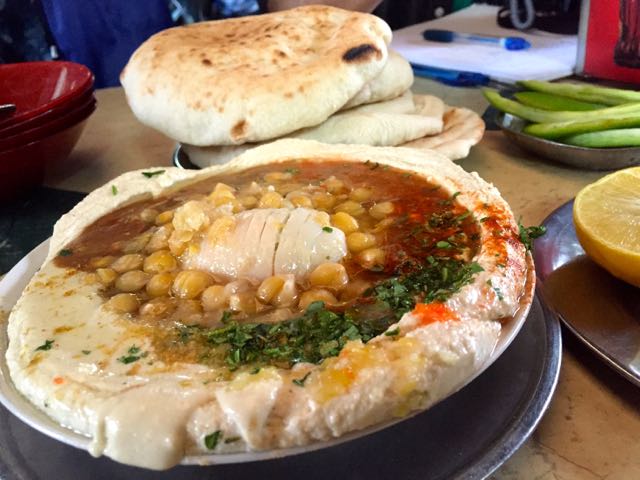
1. Hummus at Shlomon & Dorrone, Carmel Market. Ms. Moran of Delicious Israel took me on a walking/ tasting tour of the market. She told me that hummus is an integral part of the Israeli diet. Of course everyone has their own recipe and there is an ongoing competition of who makes the best hummus. Israel recently won over Lebanon for making the largest hummus bowl, at a whopping 11 tons!
The proper way to eat hummus though is as a meal, not as a side or a dip. It is always warm, with the chunkier part on the outside and creamier mashed garbanzo beans placed on the inner part of the dish. It can be topped with shakshuka, chick peas, cumin and parsley. You may see a brownish looking boiled egg in the middle, which has been cooked in black tea water. On the side, I am served raw onions (cut like scoops), long peppers, lemons and warm pita bread.
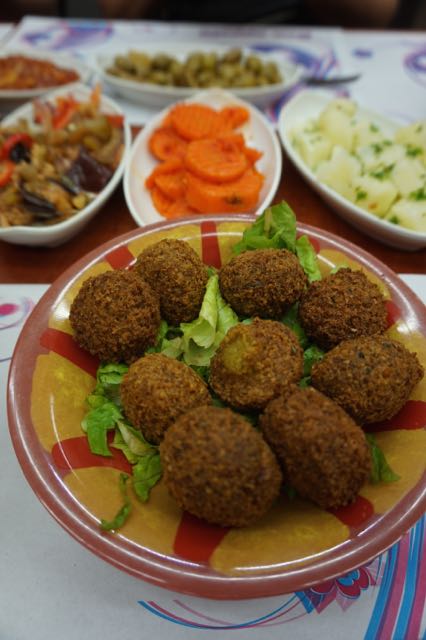
2. Falafal – Like hummus, there are debates on who makes the best falafel. It is a simple recipe using ground chickpeas, parsley, and tahini, but the art is in balancing the texture vs flavor. A good falafel should be soft and flaky on the inside, and crisp on the outside. It shouldn’t be dull and allow for one ingredient to overpower another’s flavors.
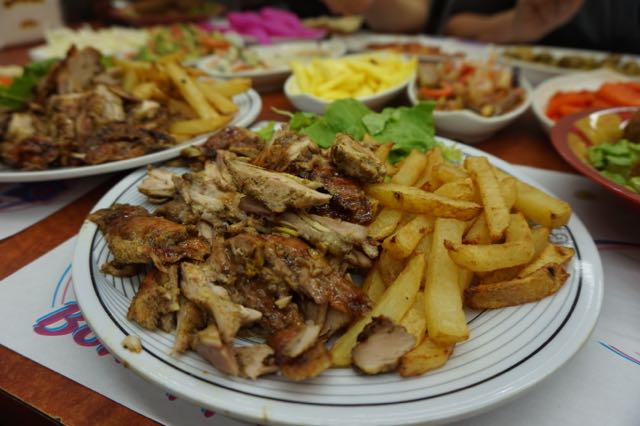
3. Shawrma at Al-Shaweesh, Jerusalem. Oh the aroma of meat roasting on an open fire, as you walk past no-name cafes in the colorful Arab markets can be quite overwhelming. The best shawarma I had was at family-run cafeteria in the Old City of Jerusalem, called Al-Shaweesh. The meat was soft and peppery taste, and it was served with a variety of colorful side salads.
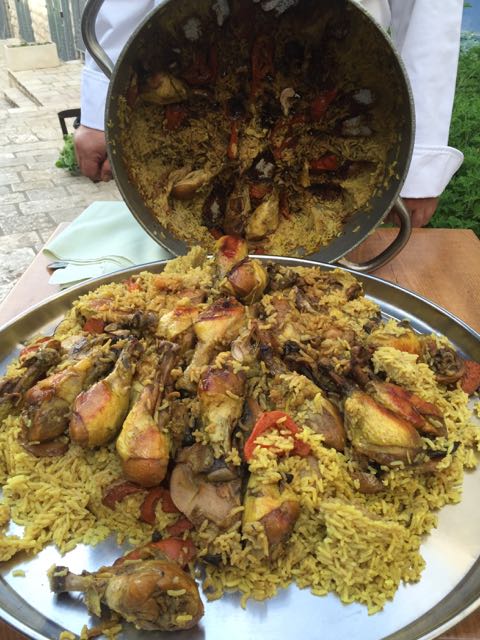
4. Maqluba at Eucalyptus restaurant, Jerusalem. A traditional Palestine and Jordanian dish, maqluba is one of those comfort foods, that when cooked right, goes straight from your mouth to your soul. The one I had at Eucalyptus had tender pieces of chicken, lots of root vegetables and turmeric rice. I helped the chef invert the pan in a maqluba turning over ceremony and enjoyed the delicious scrapes from the bottom!
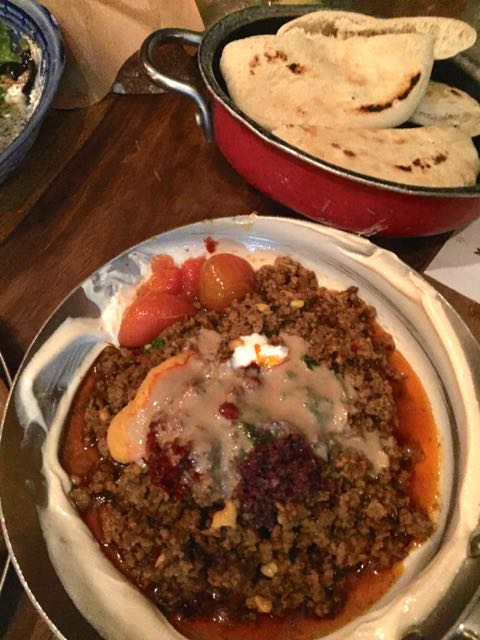
5. Shakshuka at Mahaneyehuda Restaurant, Jerusalem. Similar to the Mexican breakfast dish huevos rancheros, shakshuka is a ragout of eggs poached in a sauce of tomatoes, chili peppers, and onions, often spiced with cumin. The version at Mahaneyehuda, a happening restaurant in the famous Mahane Yehuda Market, also had flavorful ground beef mixed in. I just couldn’t stop eating!
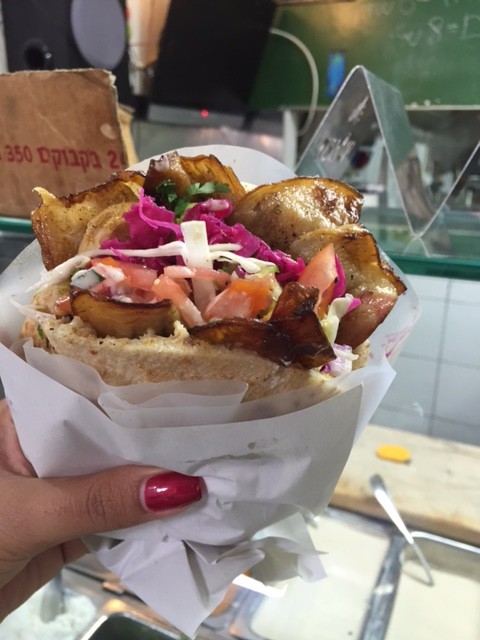
6. Sabich at Sabich Tchernichivoski, Tel Aviv. Sabich is an Israeli sandwich, consisting of pita stuffed with fried eggplant, hummus, tahini, Israeli salad, boiled potatoes (in some versions), parsley, amba, and hard boiled eggs. It is a popular street food of Israel and it’s origins stem from the Iraqi Jews who ate it on Shabbat mornings. I tried it at few different places and found Sabich Tchernichivoski to be the most fresh and flavorful. I could eat this everyday!
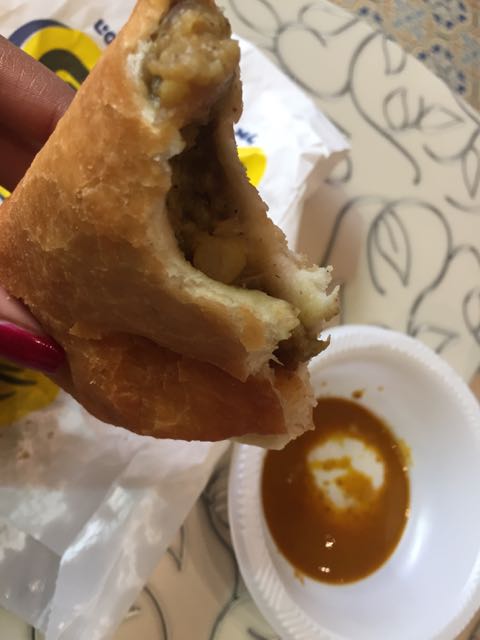 7. Sambusak at Wahad Falafel, Iraqi Market in Mahane Yehuda Market, Jerusalem. These fried savory turnovers were stuffed with spicy chickpeas and potato curry, and served with amba. They reminded me of their Caribbean cousin, Doubles. The kiosk was very small, with only 2-3 tables. It served only sambusak and falafel in take-away paper bags.
7. Sambusak at Wahad Falafel, Iraqi Market in Mahane Yehuda Market, Jerusalem. These fried savory turnovers were stuffed with spicy chickpeas and potato curry, and served with amba. They reminded me of their Caribbean cousin, Doubles. The kiosk was very small, with only 2-3 tables. It served only sambusak and falafel in take-away paper bags.
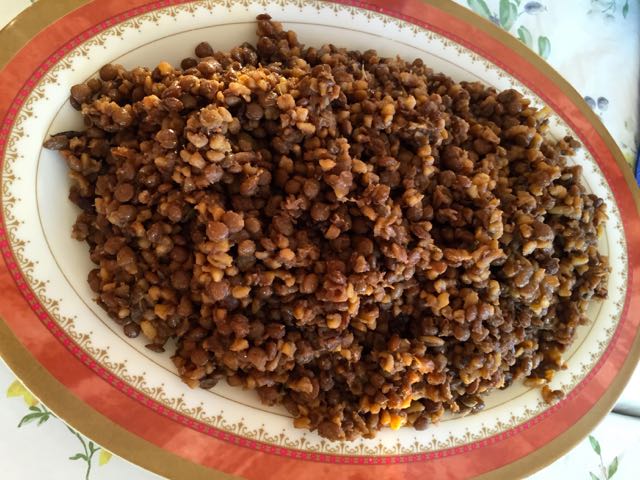
8. Majadara at Pnina’s house, Maghar village. I took a private cooking class at the home of Pnin, a Druze woman, through GalilEat. Lentils and rice is pretty common combination all over the world, but this lentils and bulgur wheat recipe was so simple yet delicious. Brown lentils were lightly seasoned with baharat seasoning and made for a great vegetarian entree or side.
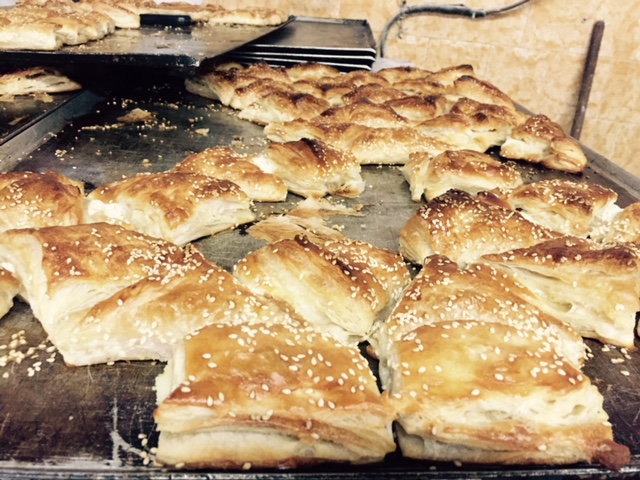 9. Bourekas at Syrian Bakery, Carmel Market in Tel Aviv. There was a little shop in the corner that looked like a tin shed that was about to fall. No name plate, address, menu or showcase. You had to step inside the bakery and point out to what you wanted (unless you spoke Hebrew). This family run operation has been around for 100-years but only the locals know about it. They undoubtedly make the best boureka, a phyllo pastry made with margarin and flour, and stuffed with either sour cheese or mashed potatoes. You can tell what’s inside by the shape of it.
9. Bourekas at Syrian Bakery, Carmel Market in Tel Aviv. There was a little shop in the corner that looked like a tin shed that was about to fall. No name plate, address, menu or showcase. You had to step inside the bakery and point out to what you wanted (unless you spoke Hebrew). This family run operation has been around for 100-years but only the locals know about it. They undoubtedly make the best boureka, a phyllo pastry made with margarin and flour, and stuffed with either sour cheese or mashed potatoes. You can tell what’s inside by the shape of it.

10. Seafood at Uri Buri Restaurant in Akko – Located on the Mediterranean, 12 miles from the Lebanese border, Uri Buri Fish Restaurant is a fisherman/ chef restaurant that serves the catch of the day like you have never tasted before. As part of the chef’s tasting meal, I tried tuna, salmon, shrimp, octopus, calamari, roe, anchovies, scallops, and much more. Every single dish was cooked very gently with a drizzle of olive oil, salt and lemon juice, keeping intact the integral flavorful of the seafood. This is by far the best seafood I ate in Israel!